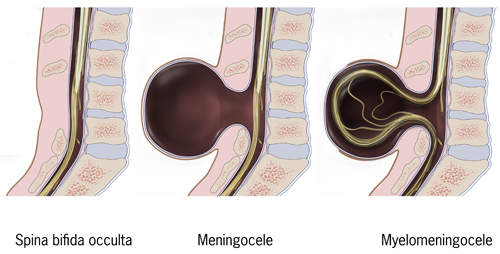Introduction
Welcome to Ephysioneeds Academy, where we shed light on Spina Bifida, a congenital condition that affects the spinal cord. Our mission is to provide compassionate insights into this condition, along with information on prevention, diagnosis, and physiotherapy-based management.
Understanding Spina Bifida
Spina Bifida is a birth defect that occurs during early pregnancy when the spinal cord and the membranes around it do not close properly. This condition has various forms, including Spina Bifida Occulta, Meningocele, and Myelomeningocele, each with its own characteristics and severity.
Types of Spina Bifida
- Spina Bifida Occulta: This is the mildest form, where the spinal cord doesn’t protrude. It often goes unnoticed as it lacks significant symptoms. It may manifest as a small dimple, birthmark, or hair growth on the back.
- Meningocele: A less common form where the protective membranes around the spinal cord herniate through an opening. Individuals with meningocele typically do not experience long-term health problems.
- Myelomeningocele (Meningomyelocele): The most severe form, it involves the spinal cord and nerves protruding through an opening in the spine. This type can lead to various complications and requires extensive medical attention.
Causes of Spina Bifida
The exact cause of Spina Bifida is not fully understood, but it is believed to result from a combination of genetic and environmental factors. These may include family history, a lack of folic acid during pregnancy, maternal diabetes, obesity, and more.
Complications of Spina Bifida
The severity of Spina Bifida can vary, leading to different complications. These may include:
- Mobility issues, ranging from weakness to paralysis.
- Orthopedic problems such as scoliosis, hip dislocation, and joint deformities.
- Bowel and bladder problems due to nerve dysfunction.
- Hydrocephalus, the accumulation of fluid in the brain.
- Chiari malformation type II, affecting brainstem function.
- Infections like meningitis.
- Tethered spinal cord, leading to progressive loss of function.
- Sleep-disordered breathing, including sleep apnea.
- Skin problems and latex allergies.
- Other complications that may arise with age, including learning disabilities and mental health concerns.
Prevention of Spina Bifida
Taking folic acid supplements before conception and during the early weeks of pregnancy significantly reduces the risk of Spina Bifida. A daily intake of 400 micrograms (mcg) of folic acid is recommended for women of childbearing age. Folate-rich foods can also contribute to this intake.
Diagnosis
Spina Bifida can be diagnosed before birth through tests such as blood tests, ultrasound, and amniocentesis. After birth, X-rays and MRI scans help confirm the diagnosis and assess the extent of the condition.
Treatment
Treatment of Spina Bifida often involves surgery, which can be performed shortly after birth or even during pregnancy in some cases. The surgical approach depends on the type and severity of Spina Bifida. It may include closing the opening, repairing membranes, and addressing associated issues like hydrocephalus. Physiotherapy plays a crucial role in the post-operative and long-term management of Spina Bifida.
Physiotherapy Management
Physiotherapy aims to enhance the quality of life and independence of individuals with Spina Bifida. It includes:
- Ambulatory supporting devices such as walking aids and braces.
- Exercises for strength, hydrotherapy, and upper and lower body conditioning.
- Training for independence in daily activities.
- Joint splints to prevent muscle contractures.
- Education on joint protection to prevent arthritis.
- Mobility aids and equipment to increase independence.
- Balance and coordination exercises.
- Wheelchair skills training.
Conclusion
At our Academy, we emphasize compassionate understanding, prevention through folic acid intake, early diagnosis, and the importance of physiotherapy in managing Spina Bifida. By addressing the physical challenges associated with this condition, we aim to empower individuals to lead fulfilling lives.
At Ephysioneeds Academy, we offer comprehensive training for physiotherapists looking to progress their skills. Our courses include dry needling certification, advanced physiotherapy techniques, and sports injury treatment. Our rehabilitation certification and physiotherapy training online provide flexibility and depth. We moreover specialize in manual therapy courses and soft tissue therapy certification. Explore our sports fellowship in physiotherapy and detailed A-Z knee and shoulder treatment courses. Additionally, the Tapedia Taping Encyclopedia is an essential resource for mastering taping techniques.

